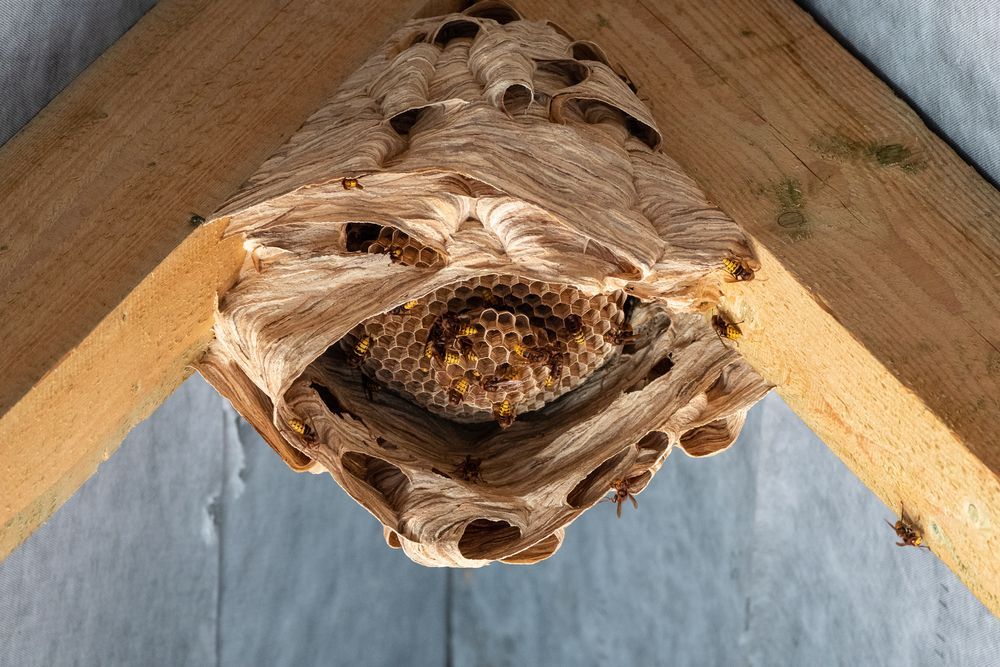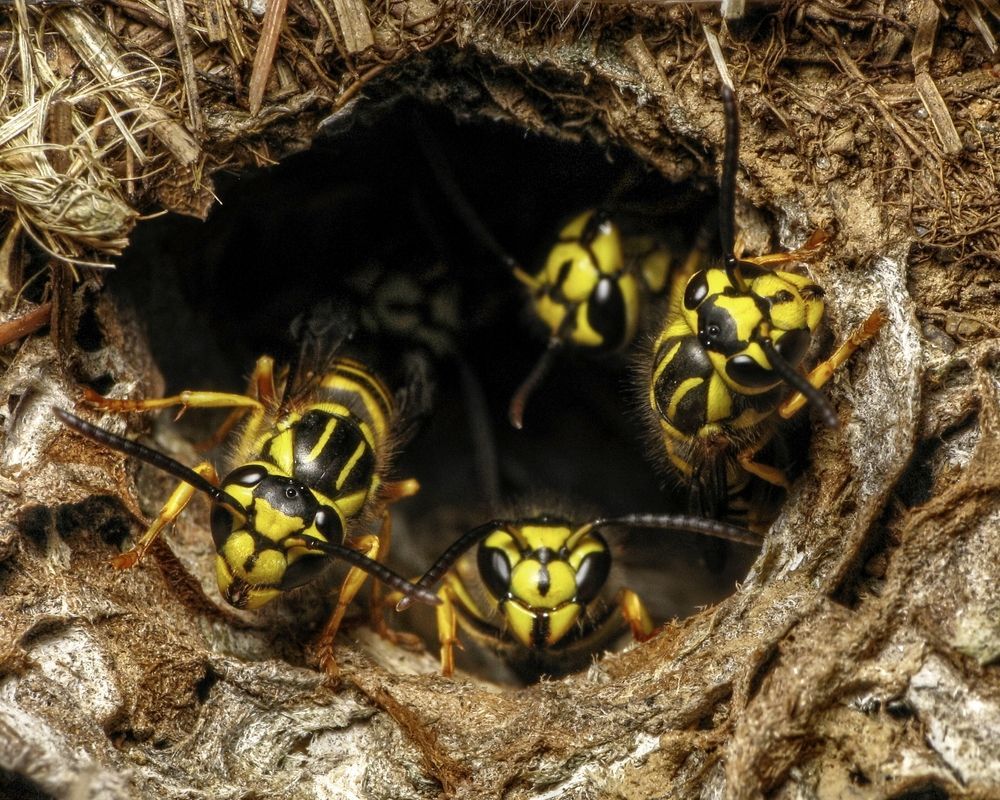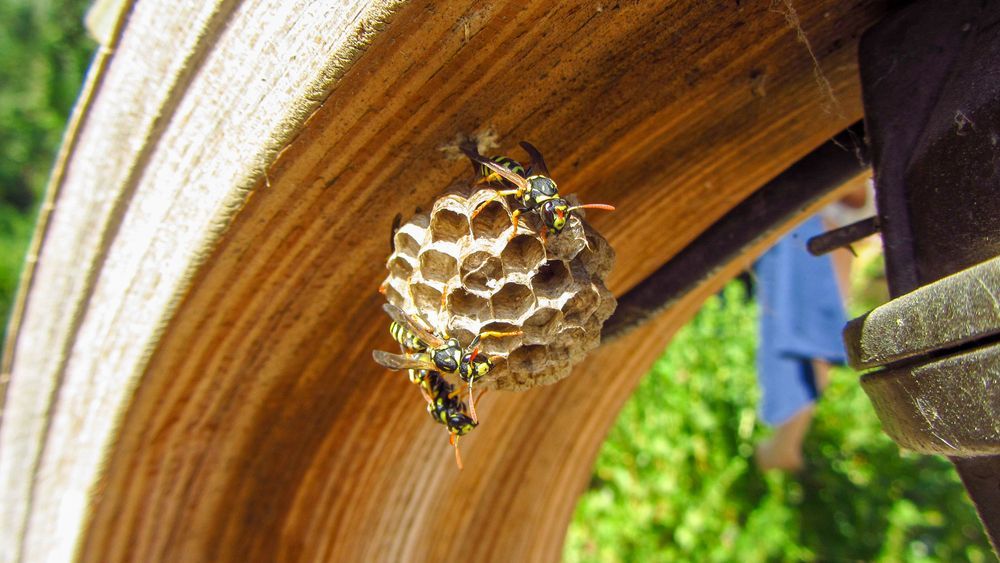Pest Control for Stinging Insects Nesting in Your Yard
Safe and Effective Strategies for Managing Stinging Insect Nests

Homeowners and gardeners alike can relate to the frustration of discovering a stinging insect nest on their property. These uninvited guests can turn a relaxing summer day into a buzzing nightmare. This blog will guide you through the process of identifying, removing, and preventing nests from wasps, hornets, and yellow jackets.
Stinging insects, such as wasps, hornets, and yellow jackets, are not just a nuisance—they can pose serious health risks. Their stings are painful and, for some people, can trigger allergic reactions. Early detection and removal of their nests are crucial to maintaining a safe and enjoyable outdoor environment.
Learn more about Residential Wasp Control
Identifying Stinging Insect Nests
Common Stinging Insects
Wasps: Wasps are slender with narrow waists and long legs, giving them a distinct appearance. They come in various colors, including black, yellow, and red, and are commonly found in gardens, parks, and forests. Wasps are known for their aggressive behavior, especially when their nests are disturbed. They can build nests in trees, under eaves, or in other sheltered locations, using chewed wood fibers to construct paper-like structures. Some species of wasps are solitary, while others live in large colonies.
Hornets: Hornets are a type of wasp but are generally larger and more robust in appearance. They have powerful bodies and can be identified by their distinctive white and black or brown and yellow markings. Hornets are more aggressive than other wasps, and their stings can be more painful due to the larger amount of venom they inject. Hornets build large, paper-like nests, often in trees or shrubs, but sometimes in attics or other sheltered areas. Their nests can house hundreds of individuals, and they are very protective of their colony.
Yellow Jackets: Yellow jackets are smaller than hornets, with bright yellow and black markings that make them easily recognizable. They are particularly aggressive and can sting multiple times, unlike bees that generally sting once. Yellow jackets often build their nests in the ground, but they can also be found in wall cavities, attics, or other enclosed spaces. These nests can grow quite large, housing thousands of yellow jackets by the end of summer. Yellow jackets are scavengers and are often attracted to food and sugary drinks, making them common pests at outdoor gatherings and picnics.
Bees in Missouri
While bees are generally less aggressive than wasps, hornets, and yellow jackets, they still warrant attention due to their potential for stinging and their important ecological role. In Missouri, the two most prevalent types of bees are the honey bee and the bumble bee. Understanding their behavior and nesting habits can help you coexist peacefully with these beneficial insects.
Honey Bees: Honey bees are small, amber-colored insects with fuzzy bodies that enhance their ability to collect pollen. They are vital pollinators, playing a crucial role in the growth of fruits, vegetables, and flowers. Honey bees typically build their nests, known as hives, in hollow trees or man-made structures such as beekeeping boxes. These hives can house thousands of individuals, all working together in a highly organized colony. Honey bees are generally non-aggressive and sting only when threatened. However, it's important to exercise caution around their nests, especially during peak activity periods in the spring and summer.
Bumble Bees: Bumble bees are larger and more robust than honey bees, with distinctive black and yellow markings and a fuzzy appearance. They are also important pollinators and are particularly effective at pollinating certain types of plants due to their size and the way they vibrate flowers to release pollen. Bumble bees typically build their nests in the ground or in protected areas such as compost piles, woodpiles, or abandoned rodent burrows. These nests are smaller than those of honey bees, housing a few hundred individuals. Bumble bees are generally docile but can become defensive if their nest is disturbed. It is advisable to leave bumble bee nests undisturbed to benefit from their pollination services.
By understanding the characteristics and habits of bees in Missouri, you can take appropriate measures to avoid unnecessary conflicts while supporting their crucial role in the ecosystem.
See our Pest ID guide for more information on the different types of stinging insects found in Missouri.
DIY Nest Removal Tips
Safety Precautions
Before attempting to remove any nest, take these essential safety precautions:
- Wear protective clothing, including long sleeves, pants, gloves, and a hat with a veil to protect yourself from potential stings.
- Perform the removal at dusk or dawn when the insects are less active and less likely to swarm.
- Have a clear escape route planned in case the insects become aggressive, ensuring you can quickly distance yourself from the nest.
- Consider informing a neighbor or someone nearby about your plans, so they are aware of the situation and can offer help if needed.
- Keep a can of insecticide spray specifically designed for the type of insects you are dealing with as an additional precaution.

Step-by-Step Guide for Safe Nest Removal
- Assess the Nest Size: Begin by carefully observing the nest from a safe distance. If the nest is small and easily accessible, it may be safe to remove it yourself. However, if it’s large, located high up, or in a difficult-to-reach area, it’s best to call a professional pest control service to handle the removal safely.
- Gather Equipment: To prepare for nest removal, you’ll need a long-handled tool such as a pole or rake, insecticide spray specifically labeled for wasp and hornet control, and a sturdy plastic bag. Additionally, consider wearing protective clothing, including gloves, long sleeves, and a face mask, to minimize the risk of stings.
- Approach the Nest Slowly: Approach the nest with caution and move slowly to avoid agitating the insects. Stand at a safe distance and thoroughly spray the nest with the insecticide, ensuring that the entire nest is saturated. Follow the instructions on the insecticide label for proper usage. After spraying, step back and wait for at least 24 hours to ensure that all the insects are dead.
- Remove the Nest: After the waiting period, carefully inspect the nest to ensure there is no remaining insect activity. Once you’re sure all the insects are dead, use the long-handled tool to gently remove the nest from its location. Place the nest in the plastic bag, seal it tightly, and dispose of it in an outdoor trash bin. Be cautious and avoid direct contact with the nest to prevent any potential stings.
Recommended Tools and Equipment
- Insecticide spray
- Long-handled tool (like a broom or rake)
- Protective clothing
- Flashlight (for dusk or dawn removal)
- Plastic bag (for disposal)

When to Call Steve's Pest Control
Indications that It’s Time for Professional Help
If the nest is too large, difficult to reach, or populated by particularly aggressive species, it’s best to call a professional. Attempting to remove such nests yourself can result in serious injury. Professionals have the right equipment and expertise to handle these situations safely. They can also identify the type of insects you are dealing with and provide advice on how to prevent future infestations. Taking the DIY route might seem tempting, but without proper knowledge and tools, the risks far outweigh the benefits.
Stinging insects can be a nuisance, but with the right approach, you can manage and prevent their nests effectively. Early detection, proper identification, and safe removal methods are key. While DIY solutions can handle smaller nests, don't hesitate to call professionals for larger or more dangerous infestations.
Your peace of mind and safety are paramount. Share these tips with your community, and consider consulting a professional to keep your home and garden insect-free.

Say Goodbye to Stinging Insects Nesting in Your Yard

Steve Pest Control

Steve’s Pest Control is a full-service pest control business run by a team of experts who are dedicated to taking care of your pest problems once and for all. We guarantee all of our pest control services with 100% customer satisfaction to ensure you are receiving the best.
Contact Information
© 2022 Steve's Pest Control. All Rights Reserved.
Background Vector Created by FreePik.
We will get back to you as soon as possible.
Please try again later.






